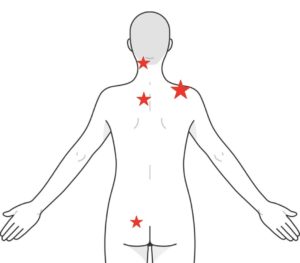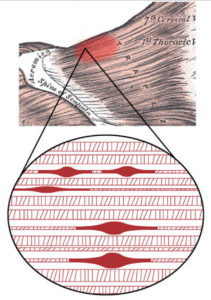Many people probably have experienced this: After finishing a long, hard working day, you try to massage your shoulder but find there’s a bend-like distribution pain on your muscle which hurts to press. That is a myofascial trigger point.
Myoascial trigger points are described as localized tightness and tender spots in a certain muscle. These points are not generally caused by acute local trauma, inflammation, degeneration, neoplasm nor infection.
Some common trigger points can be easily found at the base of our skull, and between our neck and the tip of shoulder. Trigger points are a concentrated spots of tonically active muscle fibres.

Causes of trigger points
Myofascial trigger may develop through sustain low level contraction. This means that when our head and neck muscles are tonically active (due to posture), they will be more predisposed to developing a trigger point. When muscles are active/over sustained in certain positions, you are decreasing how much blood can perfuse the muscle intramuscularly. Therefore, it is susceptible to ischemia, hypoxia, and a build of acidity. As result, the muscle is subject to increase muscular tenderness and potential referred pain across certain distribution patterns.

Myofascial trigger points characteristics
- Part of a taut band
- Tender upon palpation
- Reproduce familiar pain
- Associated with sustained release of neuro transmitter
Myofascial trigger points symptoms
- Unilateral pain
- Released by heat, but aggravated by cold
- Deep and dull pain
- Tenderness
- Sleep disturbance
- Local twitch response
Management for myofascial trigger point
- Dry needling. Research found that dry needling can suppress the irregular neural signal within the muscle fibre which will eventually result in the releasing of muscle tension
- Stretching. A gentle stretching exercises to help ease the pain in your affected muscle.
- Posture training. Improving your posture can help relieve myofascial pain, particularly in your neck.
- Massage. Massage on affected muscle may help you relieve From your pain.
- Heat. Increasing circulation can help relieve muscle tension and reduce pain.
